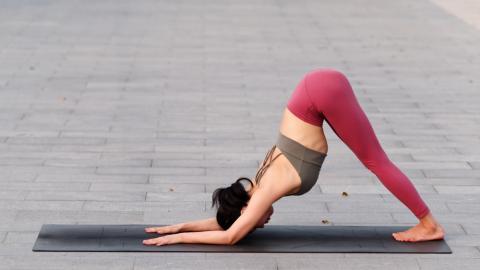
Most of us have tried our hand at yoga at some point in life. It may have been a college fad, or a newbie job one. Or it may have been something far more health-oriented and passion-driven. So let’s talk a little about yoga asanas today and that too of a specific kind.
What Is An Inversion Pose?
What do we mean when we say inversion poses? Anything that puts your hips higher than your heart and your heart higher than the head is an inversion pose. This may involve bending down at the waist, or a complete headstand. Even a simple downward dog is an inversion pose, as is the far more complicated and taxing hand or shoulder stand.
The idea of an inversion pose is simple: to let blood reach parts of your body otherwise affected by gravity. Imagine you are on a long drive, and mostly using your right hand on the steering wheel. Doesn’t switching to the left hand when the right is tired provide much-needed relief? In the same way, an inversion pose provides much better blood flow to the brain and the heart and flushes them with oxygen and nutrients.
The Benefits Of Inversion Poses
- Inversion poses let the brain, the head (and face), and the heart get flush with blood. Presenting the other end to gravity helps the blood flow faster and without hindrance to your upper body which otherwise gets blood only because the heart pumps tirelessly to go against gravity. This helps uplift your mood as well.
- Inversion poses also encourage better blood circulation to every other part of your body, including your face, thus proving to be a rather invaluable anti-aging tool.
- Inversion poses are said to be great for the crown chakra of our body, which holds our prana and amrita. Over the course of the years, this amrita is said to flow down the body and thus cause mortality. But inversion poses help in retaining the amrita in its rightful place and thus promote longevity and better chakra circulation.
- The blood flowing to your brain also improves energy and encourages clearer thought process.
- Inversion poses are also thought to better the lymphatic system circulation, which in turn boosts immunity and promotes wellbeing. Plus it also helps clear out any blockage in the lungs or sinus cavities.
- These poses help build core strength as well—and trust us—while the yoga gurus make it look easy as pie, it takes some serious strength to get these done. And not only do you have to develop some basic core strength before you do these, but doing them will also bring your core strength to its zenith. Plus, imagine the wonders these would do for your metabolism.
- Inversion poses are no cakewalk and other than muscle strength and a bit of daring, they also take a fine balancing act to do.
- While any exercise can and does give you a high, inversion poses are a whole new ballgame. Other than the runners high you get because of the flush of endorphins in your body, managing to do a headstand (supported or otherwise) is a massive achievement. To be able to do something with your body that you have only marveled at till now is a confidence boost like none other.
- Unsupported full inversion poses also help increase your focus. If you lose your focus, and then your balance, well, you take a tumble. So concentration is key in inversion poses.
- Finally, the most wonderful take home from inversion poses is a newfound ability to laugh at yourself. Because when you start, you are going to fall and make a rather funny scene every time you fall. And the best way to tackle it is to laugh at yourself, dust off, and start afresh.
When Not To Do Inversions
There are ten fantastic reasons to do inversion poses that we just mentioned—now let us mention when not to do them. Remember, always, that whenever you start a new exercise regime—even yoga—you should consult your doctor in case you have any ongoing, recurrent, or chronic medical conditions. In case an asana is making you short of breath or dizzy or just generally unwell, stop. Tell your teacher and take medical advice post haste. Yoga can only help if you can do it well and increase your health quotient alongside. If it makes you worse for the wear, then it’s a no go for a bit.
As a generality, people with blood pressure issues, heart problems, migraines, neural issues, and spinal pain, as well as pregnant women or women on their period, may want to avoid inversion poses. If a doctor gives you a thumbs up, and you feel up to doing these twisty asanas, then, by all means, give it your best shot.
As a rule, always listen to your body and let it tell you what can or should not be done. If you are healing from an injury of any sort, this is not the time to try inversion poses. While this doesn’t mean you shouldn’t push your physical limits, it just means that you shouldn’t push yourself till you or something breaks.
Common Inversion Poses
Two poses in the Surya Namaskar itself are inversion poses: the Uttanasana or the forward fold pose and the Adho Mukha Svanasana or the downward-facing dog. The Chakrasana / Ardha Dhanurasana or the wheel pose and the Halasana or the plow pose are also other popular inversion poses that stretch the spine and activate the thyroid gland. Then come the shoulder stand, the headstand and the handstand; known as Sarvangasana, Sirsasana and the Adho Mukha Vrakasana. The last three take a lot more core strength and balance to be done when done with no props but are all the more beneficial for it.
So go ahead and get inverted if you and your body are up for it. Ultimately exercise is great for your body, soul and of course, the heart.








